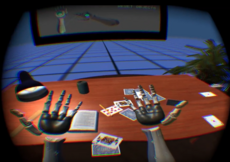Difference between revisions of "Hand tracking"
Jump to navigation
Jump to search
m (Text replacement - "devices" to "gadgets") |
|||
| (4 intermediate revisions by the same user not shown) | |||
| Line 1: | Line 1: | ||
| + | [[File:LeapDesk.png|thumb|Hand tracking working in a virtual reality scene]] | ||
'''Hand tracking''' is technology for tracking hands in 3D. | '''Hand tracking''' is technology for tracking hands in 3D. | ||
It is typically done using infrared sensors and computer vision. | It is typically done using infrared sensors and computer vision. | ||
| − | + | [[Leap motion]] is a company that makes hand tracking gadgets and software. | |
| − | [[ | + | The [[Meta Quest Pro]] has a form of hand tracking, but it does not capture the full range of human motion. It also has latency and limited range for detecting the hands. |
| + | |||
| + | Headsets with hand tracking include the [[Project North Star]] headsets. | ||
| − | + | One of the goals of typical hand tracking systems is to provide an accurate geometry mesh of the user's hands to a computer application, for example, a VR game. | |
==References== | ==References== | ||
| Line 13: | Line 16: | ||
[[Category:3D tracking]] | [[Category:3D tracking]] | ||
| + | [[Category:Control peripherals]] | ||
Latest revision as of 18:53, 1 February 2025
Hand tracking is technology for tracking hands in 3D.
It is typically done using infrared sensors and computer vision.
Leap motion is a company that makes hand tracking gadgets and software.
The Meta Quest Pro has a form of hand tracking, but it does not capture the full range of human motion. It also has latency and limited range for detecting the hands.
Headsets with hand tracking include the Project North Star headsets.
One of the goals of typical hand tracking systems is to provide an accurate geometry mesh of the user's hands to a computer application, for example, a VR game.
